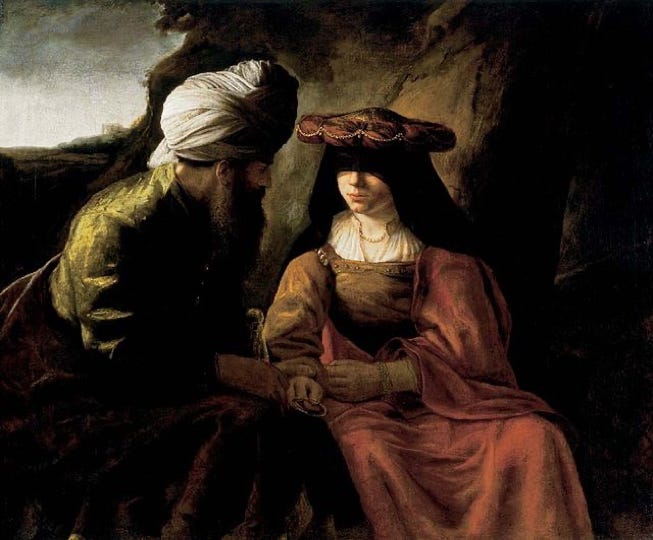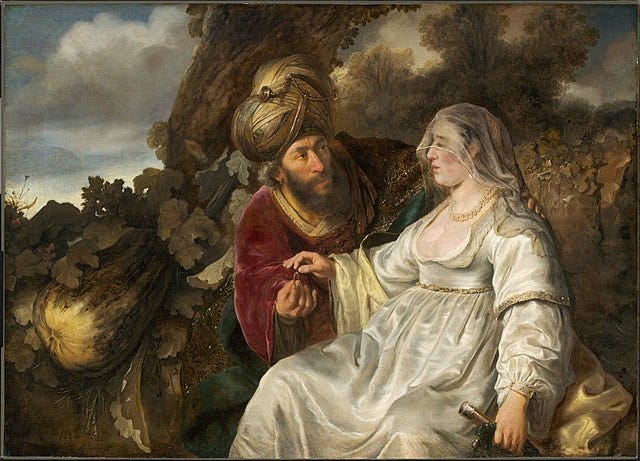Hello friends! I know I said I woudln’t get into the habit of two-part newsletters BUT since this is about Tamar, who is equally as important to me as Ruth, I thought it was worth a deeper look. I hope you enjoy part 1, and part 2 will be with you next week!
In morning prayer we are getting towards the end of the Joseph cycle, but did you notice that someone significant was left out?
As has happened in years previous, we didn’t get Genesis 38 in the lectionary, meaning that Tamar was left out.1 This is a travesty! Not just because she is one of the most interesting women in Genesis, but also because Genesis 38 does significant work for helping us to understand the rest of the story of Joseph (known in Biblical studies as ‘the Joseph Cycle’).
You’d be forgiven for thinking that Genesis 38 is just an interruption in the narrative, something which the editors didn’t know what to do with that ended up in a strange location in Geneis. In fact, some biblical scholars think that the location of the text is an accident and it should be placed elsewhere.2
Robert Alter, in his book ‘The Art of Biblical Narrative’ (which I highly recommend!) looks at the Joseph cycle from literary point of view. This means that he is more interested in the final form of the book, its language and symbolism, than in historical issues like who wrote it, and whether ch 38 belongs somewhere else.
He makes the important point that there are lots of parallels between chapters 37-39. These are the parallels we will be exploring this week and next, so read on to find out why Tamar might be the key to understanding the Joseph cycle…
Who is Tamar?
Rembrandt's school: Tamar (Wikimedia.commons)
In case you’re not familiar with her, let me introduce you to one of my favourite women of Genesis. When we first encounter her, Tamar is married to one of Judah’s sons, Er. He did ‘what was evil in the Lord’s sight’ (v 7) and he died as a result. In ancient Israel it was usual for the widow of a man to be given in marriage to his brother so that she might be given a son (cf Ruth 4 and Deut 25). As per this custom, Tamar is given to Onan, but before long he also dies!
Judah has another son, Shelah, but at this point, he is reluctant to give him to Tamar in case he dies too (v 11). So, he sends her back to her father’s house claiming that she has to wait to marry Shelah because he is too young. The reader, however, knows that Judah has no intention of fulfilling his duty to his daugher-in-law giving Shelah to her.
After a while, Shelah grows up and Tamar realises that Judah intends to keep him from her. She waits until the sheep-shearing festival, a time of celebration when she knowns that Judah will have been engaging in the festivities, and she disguises herself as a roadside prostitute and locates herself in a place where he will pass by.
He takes the bait, but before she permits him to sleep with her, she asks for a deposit. She asks for his ‘signet and cord’, which Robert Alter describes as being 'equivalent to a person’s major credit cards’ as security while she waits for his payment of a goat (v 18).
To cut the rest of the narrative short - she becomes pregnant, he is outraged and claims she should be burned. But then, Tamar says “Take note, please, whose these are, the signet and the cord and the staff.” (v 25). Insert the classic drums from Eastenders here.
Ultimately, Tamar gets two sons and the respect of her father-in-law, who eventually admits that she was ‘more righteous’ than him.
Quite the story! But how does it fit with the rest of the Joseph cycle?
Links with the rest of the Joseph cycle
Ferdinand Bol - Judah and Tamar, wikimediacommons.org
This passage has important similarities with the surrounding chapters, indicating that, in contrast with the views of some scholars, it belongs where we find it.
The first of these similarities is clothing. Assumptions about both Joseph and Tamar are made on the basis of clothing.
In ch 37, Joseph is sold by his brothers and they plot to convince their father that he has been killed by a wild animal. How do they do so? The text says that
31 Then they took Joseph’s robe, slaughtered a goat, and dipped the robe in the blood. 32 They had the long robe with sleeves taken to their father, and they said, “This we have found; see now whether it is your son’s robe or not.” 33 He recognized it, and said, “It is my son’s robe! A wild animal has devoured him; Joseph is without doubt torn to pieces.”
In chapter 39 clothes are also key to events surrounding Joseph. The wife of Potiphar wants to seduce him, and when he refuses to go along with her wishes she grabs hold of his outer garment which is left in her hand when he flees from her.
vv 14-15 tells us that she hatched a plan to use the garment as a basis on which to claim that Joseph had tried to assault her, which would bring about her husband’s punishment of him.
Here we have two incidences where clothes play an important part in Joseph’s story. What about Tamar?
In v 14 we read that Tamar ‘put off her widow’s garments, put on a veil, wrapped herself up, and sat down at the entrance to Enaim, which is on the road to Timnah’. She disguised herself in order to make it possible to seduce Judah. For this reason Peter Bekins says that ‘the plot turns on deception and Joseph's garment is used as 'proof' in the climax in a similar manner to Judah's staff and seal in Genesis 38'.3
Like Joseph, then, clothes are key to Tamar’s story.
This is one of several similarities that highlight the relationship between Genesis 38 and the rest of the Joseph cycle. Tune in next week when we will look at some more of them!
This was because Ash Wednesday, which has its own set of readings, fell on the day in between Gen 37 and 39, but she has been left out of the lectionary in other years too!
Von Rad claims that Genesis 38 ‘has no connection at all with the strictly organised Joseph story’, Soggin calls it ‘obviously an independent literary unit’ and Westermann describes it as an ‘insertion’ to the Jacob story, rather than the Joseph cycle. (von Rad, G., Genesis: A Commentary (London: S.C.M. Press, 1961), p 351, Soggin, A. 'Judah and Tamar (Genesis 38)' in McKay, H. A., and Clines, D. J. A., Of Prophets’ Visions and the Wisdom of Sages: Essays in Honour of R. Norman Whybray on His Seventieth Birthday, The Library of Hebrew Bible/Old Testament Studies (London: Bloomsbury Publishing, 1997), p 281), Westermann, C., Genesis 37-50; a Commentary (London: SPCK, 1986), p 49)
Bekins P. Tamar and Joseph in Genesis 38 and 39. Journal for the Study of the Old Testament. 2016;40(4):375-397, p 376





